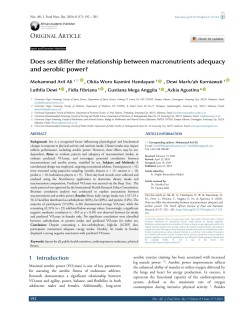Does sex differ the relationship between macronutrients adequacy and aerobic power?
Abstract
Background: Sex is a recognized factor influencing physiological and biochemical changes in response to physical activity and nutrient intake. Dietary intake may impact athletic performance, including aerobic power. However, these effects may be sex-dependent.
Aims: to evaluate pattern and adequacy of macronutrient intake; to evaluate predicted VO2max, and investigate potential correlations between macronutrients and aerobic power, stratified by sex.
Subjects and Methods: A correlational design was employed, targeting recreational athletes. Participants (n = 52) were recruited using purposive sampling (aerobic dancers n = 15, runners n = 18, pesilat n = 10, badminton players n = 9). Three-day food records were collected and analyzed using the NutriSurvey application to determine dietary intake and macronutrient composition. Predicted VO2max was assessed via the Beep Test. The study protocol was approved by the Institutional Health Research Ethics Commission. Bivariate correlation analysis was conducted to explore associations between macronutrients and aerobic power.
Results: Mean daily energy intake was 1,417.19 ± 56.12 kcal/day distributed as carbohydrate (46%), fat (40%), and protein (14%). The majority of participants (57.69%, n=30) demonstrated average VO2max, while the remaining 42.31% (n = 22) exhibited below-average values. Interestingly, a significant negative moderate correlation (r -.565 as p < 0.05) was observed between fat intake and predicted VO2max in females only. No significant correlations were identified between carbohydrate or protein intake and predicted VO2max for either sex.
Conclusion: Despite consuming a low-carbohydrate, high-fat (LCHF) diet, participants maintained adequate energy intake. Notably, fat intake in females displayed a strong negative association with predicted VO2max.
Keywords: Sports for all, public health nutrition, cardiorespiratory endurance, physical fitness.
Full text article
Authors
Copyright (c) 2024 Mohammad Arif Ali, Oktia Woro Kasmini Handayani, Dewi Marfu'ah Kurniawati, Luthfia Dewi, Fidia Fibriana, Gustiana Mega Anggita, Azkia Agustina

This work is licensed under a Creative Commons Attribution 4.0 International License.
-
Attribution — You must give appropriate credit, provide a link to the license, and indicate if changes were made. You may do so in any reasonable manner, but not in any way that suggests the licensor endorses you or your use.
-
No additional restrictions — You may not apply legal terms or technological measures that legally restrict others from doing anything the license permits.





